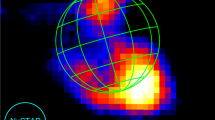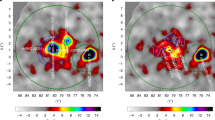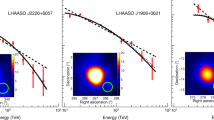Abstract
THERE has been little success in the search for anisotropies in the arrival directions of ultra high energy cosmic rays. Data on 50 events of very high energy, having an arrival direction which is ‘not obviously isotropic’, have however, been collected by the Sydney extensive air shower group1. The data were recorded over a period of 5 yr and, as the world total of such events is likely to increase only rather slowly, this seems to be the appropriate time to combine these data with comparable data from the Northern Hemisphere arrays operated at Cornell (United States), Haverah Park (United Kingdom) and Volcano Ranch (United States). The arrival directions of 87 showers with primary energies above a few times 1019 eV are discussed here. It is shown that there are no large deviations from an isotropic distribution and it is concluded that the ultra high energy cosmic rays are most likely to come predominantly from extra-Galactic sources.
This is a preview of subscription content, access via your institution
Access options
Subscribe to this journal
Receive 51 print issues and online access
$199.00 per year
only $3.90 per issue
Buy this article
- Purchase on Springer Link
- Instant access to full article PDF
Prices may be subject to local taxes which are calculated during checkout
Similar content being viewed by others
References
Bell, C. J., et al., Proc. thirteenth International Conference on Cosmic Rays, Denver, 4, 2525–2528 (1973).
Bell, J. C., et al., J. Phys. A (in the press).
Delvaille, J., Kenziorski, F., and Greisen, K., J. phys. Soc. Japan, 17, Suppl. A-III, 76–83 (1962).
Simopoulou, E. P., thesis, Cornell Univ. (1962).
Edge, D. M., et al., J. Phys. A 6, 1612–34 (1973).
Linsley, J., Proc. eighth International Conference on Cosmic Rays Jaipur, 4, 77–99 (1963).
Hollows, J. D., thesis, Univ. Leeds. (1968).
Karakula, S., Osborne, J. L., Roberts, E., and Tkaczyk, W., J. Phys. A 5, 904–915 (1972).
Osborne, J. L., Roberts, E., and Wolfendale, A. W., J. Phys. A. 421–433 (1973).
Vallée, J. P., and Kroneberg, P. P., Nature phys. Sci., 246, 49–51 (1973).
Stecker, F. W., Phys. Rev. Lett., 21, 1016–1018 (1968).
Author information
Authors and Affiliations
Rights and permissions
About this article
Cite this article
LINSLEY, J., WATSON, A. Isotropy of the arrival directions of ultra high energy cosmic rays. Nature 249, 816–817 (1974). https://doi.org/10.1038/249816a0
Received:
Revised:
Issue Date:
DOI: https://doi.org/10.1038/249816a0
This article is cited by
-
Cosmic rays and the Galaxy
Nature (1975)
-
Origin of ultra high energy cosmic rays
Nature (1975)
Comments
By submitting a comment you agree to abide by our Terms and Community Guidelines. If you find something abusive or that does not comply with our terms or guidelines please flag it as inappropriate.



